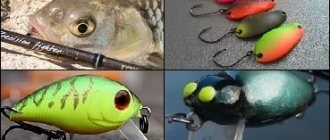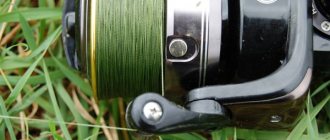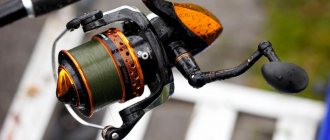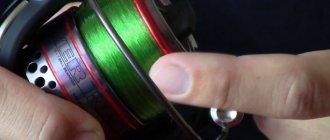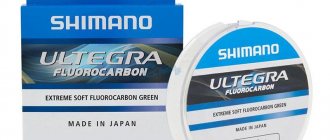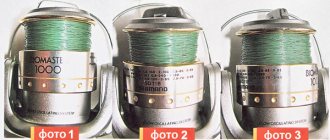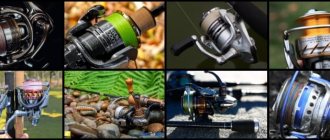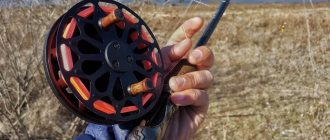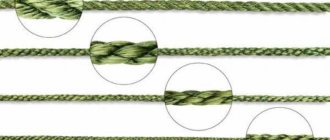The fishing line must be wound evenly, with a certain controlled tension, in order to avoid “beards” and unwanted bumps. After completing the process, you should secure the fishing line with a special clip on the reel - this will protect it from weakening and falling off the spool.
Fishing is full of all sorts of tricks that are revealed gradually, with experience. It would seem that the simplest task is to wind the fishing line onto a reel, but how many subtleties are hidden in this seemingly simple process! People who are just learning the mysteries of fishing have no idea how important this “trifle” can become. An incorrectly laid thread can fall off, twist and form “beards”, which can make fishing not just uncomfortable, but even impossible in principle.
Today we will figure out how to correctly calculate the amount of working thread or cord, find out what backing is and learn the intricacies of laying fishing line on different types of reels. We hope this publication will contribute to your advancement in the art of fishing. Let fishing bring pleasure and enviable catches, and an incorrectly laid fishing line does not hinder this!
- Selection of reel and line
- Determining line length and backing
- Winding profile
- Securing the line to the spool
- Winding fishing line onto a spinning reel
- Features of inertial coils
- Animator equipment
- Practical advice from experienced fishermen
And here are as many as FIVE options for how to tie a fishing line to a reel. Five knot options, I mean.
Important parameters
Depending on how and with what technical parameters you decide to choose a reel for ultralight, the operation of the entire gear will depend. A reel for an ultralight spinning rod should harmoniously complement it, not upset the balance and allow it to successfully handle the most delicate and light lures.
The most popular ultralight spinning rods have the following features:
- length from 1.6 to 2.35 m;
- test up to 5 grams;
- the system is parabolic or slow.
The weight of such whips should not exceed 110 grams. This can be achieved through the use of high-tech material in their production - carbon fiber (carbon fiber).
How to choose a good reel for ultralight?
It is clear that such a light whip will only be harmoniously combined with a light reel . Most often, when fishing with ultra-light baits, anglers use an ultralight spinning reel. But there are some professionals who believe that a properly selected baitcasting reel for ultralight will perform just as well. But, it is worth noting that classic cartoons, due to the peculiarities of this mechanism, can only fully work with those baits whose weight exceeds 10 - 12 grams .
To effectively handle baits from 1 to 6 grams, special low-profile multiplier mechanisms , which are popularly called “soap boxes,” were developed. They are designed to work with baits up to 5–6 grams , and not higher.
So, initially, when choosing a spinning reel for ultralight, you should evaluate:
- her weight;
- its size.
This is based on the fact that an ultralight spinning reel should not upset the balance of the entire tackle, make it heavier and reduce sensitivity. In order to reduce the weight as much as possible and maintain the required size of the coil for ultralight (they should not be very small, this is inconvenient), the highest quality and lightest materials are used for their production. As a result, a high-quality, reliable ultralight reel cannot be cheap .
Although, it should be noted that there are also budget reels for ultralight . A combination of various construction materials is used in their production. However, you need to know that even the best budget ultralight reels will last much less than high-quality products from well-known brands.
The next thing you should focus on when choosing an ultralight coil is:
- Line roller. It depends on its parameters whether the line will twist when fishing.
- Spool characteristics.
- Friction mechanism.
- The quality of the line brace mechanism.
- The number of bearings used, which directly affects the smoothness and reliability.
When you pick up a reel that could eventually become yours, be sure to check its stroke, the operation of all mechanisms and the compliance of the sizes of the mounting legs and reel holder on your rod.
Spool
How can you choose a reel for ultralight without taking into account the capacity of its spool? This is one of the most important operating parameters of any reel.
A suitable spinning reel for ultralight should have a spool with a capacity of 1000 to 2000. This choice will be the most practical when catching ordinary (small) trophies for such gear. But, if there is a possibility of catching larger specimens, then you can equip it with a 2500 .
You need to know that the best reels for ultralight, from well-known brands, are always equipped with several spools of different capacities . And most often they will be made of modular graphite, which provides the mechanism with the necessary lightness and balance in operation.
Also, ultralight reels can be supplied with metal or aluminum spools . This material is, of course, heavier, but it is more durable and less susceptible to impacts.
Often, in good fishing stores, you can be given a choice: ultralight reels with carbon spools or with metal ones. And sometimes the kit may include spools made of both materials.
Friction clutch
The friction mechanism can rightfully be called one of the most complex and delicate elements that any spinning reel for ultralight and more contains. Its main function is to timely remove the jerking load from the rod and thereby prevent line breakage and damage to the entire tackle. Most often, such loads occur during biting and when fishing for a trophy.
very important to correctly determine the braking force of this mechanism , which depends on the breaking load withstood by the fishing line used and, partly, on the action and test of the fishing rod.
As a rule, in most cases, a good ultralight reel has this figure ranging from two to four kilograms.
It has been noticed that inexpensive reels, as a rule, have less advanced friction mechanisms that operate with some delay, which often leads to loss of prey or to breaking of the fishing line.
Line Brackets
The mechanism of the line guide bracket must have bearings, which significantly strengthen the entire structure and prolong its operation. Also, when examining different models, always tend to choose the options with the thickest bracket . Of course, this will slightly increase the weight of the ultralight reel, but will protect the bracket from various mechanical damage.
Types of fishing lines for spinning
Not so long ago, the raw materials for making fishing lines were horsehair, silk and linen threads, and other materials of natural origin. Now the emphasis is on artificially created analogues. Fishermen are offered the following types of fishing line:
1. Monoline. It is a solid single-filament thread made of nylon, monofilament, and various types of polyamide fibers. Monofilament cord has high strength, rigidity and elasticity, but at the same time it is highly stretchable in water, which sometimes interferes with the jig fishing method. Monoline is most suitable for beginners who are just beginning to learn the intricacies of fishing. 2. Braided. High strength, abrasion resistance, and zero elongation of the fishing line are achieved due to the presence of many fibers. Braided cord is available in two versions - coated and uncoated. Disadvantages include the tendency to form knots, visibility in the water and a high risk of cutting yourself on the cord. 3. Fluorocarbon line. When immersed in water it becomes almost invisible, so it is great for leashes. It has minimal memory and rigidity, increased resistance to abrasion and ultraviolet irradiation. Does not change its properties due to temperature changes. But for all its advantages, this type of cord has low tensile strength and requires knowledge of special knots, since ordinary ones “spread” due to their rigidity.
Distinctive features of ultra-light reels
When determining which ultralight reel you need, it is always useful to know their main positive and negative characteristics.
The general positive features of such products include:
- Particularly smooth and soft running.
- The use of light alloys and carbon in their production.
- Highly balanced operation of the mechanism and absence of vibrations.
- Ability to fully work with fishing line with a diameter of 0.05 to 0.14 mm.
- Sensitive clutch with instant response.
- Possibility of preventing line twisting using the line roller.
- The braking force is quite high for such thin mechanisms.
The main features defined as negative are:
- Their scope of application is quite narrow.
- Slightly lower reliability of the entire mechanism.
- Increased difficulty to use.
- The ability of increased loads to quickly damage the transmission mechanism.
- Difficult to manufacture and repair.
Always, when choosing such a delicate mechanism, try to take models from well-known manufacturers. The highest quality reels of this class, as recognized by the vast majority of spinning players, are produced by two and “Daiwa”.
Several examples of ultralight reels
To make it easier for you to decide which reel is suitable for your ultralight, which one to choose and not regret it later, we will present several options.
Yoshi Onyx “Zero 2000”
This is an inexpensive reel from China. Aluminum and composite materials are used in its production. Contains 7 bearings. Suitable for experienced and novice spinning anglers for infrequent trips with ultra-light tackle.
SHIMANO SIENNA FE 1000
A high-quality and not very expensive reel from a well-known brand. Its body and spool are made of composite material. Weight – 225 grams. The mechanism uses roller and ball bearings. Designed for active beginner spinners.
Daiwa 17 Aegis 2003F
This is a new series of expensive sports mechanisms for ultra-light spinning tackle. It is made of carbon and aluminum alloys. Product weight – 170 grams. Meets the highest requirements for quality, reliability, sensitivity and smooth operation.
Thickness or color of spinning line
The thickness or color of the spinning fishing line has some differences when choosing them. The color of the fishing line has almost no effect on the amount of catch, because the spinner uses an invisible leash.
What does the color of the fishing line affect?
- select the color of the fishing line according to the color of the fishing spot - yellow on a sandy bottom, green in thickets of grass;
- when fishing with a jig, a bright color of the fishing line is suitable, since the angler must control the wiring;
- The most noticeable to the eye is the white and yellow fishing line.
Which diameter to choose
There are many opinions on the diameter of the fishing line for spinning fishing. Regardless of the diameter, it must be a thin and strong thread, as all anglers support. Only with regard to the fishing line for a spinning rod, the situation is a little different.
The predator, having grabbed the bait, does not pay much attention to the fishing line. The diameter of the line, or its thickness, affects the casting distance, especially with a spinning reel.
Useful video
In the video below we will look at a short overview of ultralight reels:
Of all the reels, the lightest tackle products are the most high-tech and delicate. Therefore, it is impossible to take a formal approach to their selection and subsequent maintenance. Each harmoniously assembled ultra-light tackle, when used correctly, can give the fisherman an indescribable feeling of victory over a caught predator, and provide a significant rush of adrenaline, even if its weight does not exceed three hundred grams.
klevyj.com
If you need to buy a 1000 size spinning reel from the Riobi model range, you need to understand what rods and fishing conditions they are suitable for. A size 1000 reel must have the optimal weight, sufficient line volume and optimal gear ratio.
For which rods
In order to choose and buy the right reel for ultralight, you need to understand what the size of the reel actually means, how it affects the fishing process and how to understand whether it matches the fishing rod or not.
The size of the coil is usually indicated by a number that is a multiple of 500: 1000, 1500, 2000, etc. This encrypts the maximum length of fishing line that can be wound onto a spool at a certain thickness. Although there is no general standard, most reels are now designated by numbers according to Shimano standards.
Size 1000 reels are most often installed on ultra-light spinning rods and float rods. To buy a 1000 size spinning reel correctly, follow these recommendations:
For high-quality spinning fishing, choose reels with a smooth rotor - this is one of the most important indicators of the quality of bearings and assembly in general. One of the best models in this size is the Ryobi Zauber 1000 (8+1). In ultralight spinning rods, a front clutch is more often used. It is considered lighter and more convenient. The front brake is installed on most Riobi reels.
Float fishing places minimal demands on the quality and functionality of reels: there are rarely heavy loads, braid is not used, and the gear ratio is not so important. Here, the smoothness of the spool when rewinding is not even important, since the number of rewinds during fishing is several times less. The number of bearings may be minimal.
An inexpensive but self-sufficient option for a spinning and float rod can be the Ryobi Ecusima 1000 reel with a 4+1 bearing combination, a gear ratio of 5.1 and an adjustable handle. An important advantage is the low weight (250 g), which makes it easier to hold the fishing rod in your hand for a long time.
What fish is size 1000 suitable for catching?
The type of fish caught, first of all, depends on what rod you plan to buy a 1000 size spinning reel for:
On float rods, a size 1000 reel can confidently withstand the loads of catching small and medium-sized peaceful and semi-predatory fish: crucian carp, small perch, roach, bleak, rudd, bream, etc.
When installed on ultralight spinning rods, size 1000 reels help to fish in small reservoirs filled with a variety of small and medium-sized fish: perch, squint, chub. For catching large pike, pike perch and asp, such equipment is not powerful enough.
Reels weight
The weight of the reel is important because it makes the fishing process easier by reducing the overall weight of the fishing rod. Thanks to this, when fishing with a spinning rod, the shoulder gets less tired, and when fishing with a float, the hand gets less tired when holding the rod. An exemplary model is the Ryobi Slam 1000 reel, which weighs only 213 grams. Although, not a single Ryobi size 1000 model weighs more than 266 grams.
Length of line on spool
The main models of reels manufactured by Ryobi, produced in size 1000, have spools with the following capacity indicators:
- Ryobi Excia 1000 – 0.2 mm/130 m.
- Ryobi Zauber 1000 – 0.2 mm/130 m.
- Ryobi Amazon 1000 – 0.205 mm/145 m.
- Ryobi Arctica 1000 – 0.25 mm/130 m.
- Ryobi Slam 1000 – 0.2 mm/150 m.
- Ryobi Esucima 1000 – 0.25 mm/100 m.
Gear ratios
The gear ratio determines the ratio of the intensity of rotation of the reel handle to the speed of rotation of the spool. Therefore, all reels are divided into high-speed and power. In the Riobi lineup today you can buy an ultralight reel with approximately one gear ratio - 5:1. Consequently, these are high-speed models that have a smaller margin of safety (than power ones), but allow you to quickly reel out the fishing line. This makes it possible to animate baits in a more varied way while fishing with a spinning rod. If a size 1000 reel is installed on a float rod, the gear ratio is not at all an important characteristic when choosing.
lovisnami.ru
So, how to properly wind braid onto a reel?
To begin with, take a spool of cord and make a regular loop at the end of the braid. Then the reel is installed on the spinning rod. All you need is the butt part with the ring closest to the reel.
Having previously folded the reel bail, we pass the braided line with a loop into the nearest ring and, having made a noose loop from the cord, we throw it onto the reel spool. First, you should check whether the braided cord does not slip during the first turns of the reel and whether reliable winding occurs? If this is not the case, then the loop should be turned over to the other side. Then, lightly holding the cord with your fingers, we again begin to wind it under tension. The noose has worked, the cord is wound tightly and without slipping.
Modern inertia-free reels are capable of rotating in both directions (clockwise and counterclockwise), so it is important not to make a mistake with the winding direction. It should coincide with the working rotation of the spool.
Tips for choosing a spinning reel
On the shelves of fishing stores you can see a huge variety of spinning reels. The number of companies producing fishing reels number in the hundreds and each manufacturer has a large product range. Outwardly, they are all very similar to each other, and it will be quite difficult for an unprepared fisherman to make the right choice. In fact, everything is not so complicated, you just need to know what to look for when choosing a reel. The material from which it is made, as well as the design solution inside the reel itself, have a direct impact on the reliability and their technical characteristics.
The difficulty of choosing a spinning reel lies in many nuances, which we will discuss in more detail below. Knowing all the intricacies of both the device and the operation of the coil, the choice will be very simple.
Winding Features
Few fishermen know that in inertialess reels it is possible to lay the line in a cylinder, straight or reverse cone. By default the bobbin is set to cylindrical winding. However, it is possible to vary the styling at will.
In how to correctly wind the fishing line with a straight or reverse cone, spacer washers will help us; complete with some inertia-free spinning washers, their number reaches four. Such washers are placed on the spool axis. By increasing the spool fit by adding spacers, you will lay the cord in a straight cone, while decreasing it in a reverse cone. This is true for devices with a top clutch.
When using shim washers for a rear-friction reel, you need to remove the spool and place washers on the axle inside the reel. Only, unlike front-friction models, a higher fit will give a reverse cone, and a low cylindrical fit.
We choose a reel based on the following conditions: who will we catch, where and with what?
A big role in choosing a reel for a spinning rod is where you will fish, what kind of bait and what type of fish. For offshore fishing, a power reel with a large spool for winding a large amount of fishing line is suitable. When fishing on a river, where long casts are completely unnecessary and the fish are not large, you can use a small reel together with an ultralight rod. Depending on the weight of the bait and the casting distance, you should pay attention to the capacity of the reel spool, and, consequently, its size. When catching large fish, such as catfish or a number of other large predators, especially marine ones, preference should be given to power reels with a good margin of safety, which will allow you to restrain the fish at the time of hooking and at the time of desperate jerks of the predator.
At the same time, when fishing for relatively small fish, such as perch or river trout, you should choose a more delicate reel.
If we talk about the class of reels used on various fishing rods, then we can say that for ultra-light models of spinning rods they use 500 class reels weighing up to 170 grams. Class from 1000 to 1500 is used, as a rule, in light models of spinning rods with a length of 2.7-3.5 meters. Class 2000 is universal and the most common, suitable for medium action spinning rods. Class 3000-4000 is used for feeder rods, but for the largest fish, class 4500 reels are used.
Braided Line Diameter
The braid diameter indicated by the manufacturer on the spool is a very approximate value that may not correspond to the real one at all. After all, the same fishing line, even from premium brands, does not have a uniform thickness. The diameter of the braided cord is not a constant value along the entire length of the fishing line, but the value indicated on the spool is the average value of the diameter of the fishing line.
The problem also lies in the fact that it is almost impossible to accurately measure the diameter of the braid, and each cord manufacturer uses its own method for calculating it, based on the ratio of the mass of the material and other parameters of the multifilament fishing line.
What diameter of braid to choose...
What does the question mean: “what diameter of braid to choose” if it is not specified for what?
It means absolutely nothing without clarifying the parameters of the gear and fishing method. Moreover, if we talk about braid for spinning rods, for example, then the diameter of the braid can also fluctuate over a wide range. For spinning, ultralight is thin, delicate cords; for jig-spinning, it is much stronger, depending on the weight range of the baits used. What braid diameter should I choose in each specific case? Let's look at this in more detail, but first, a few facts about braid.
Facts about braid
What you need to know about braided fishing line:
- the braid has almost no stretch (zero stretch), which is very good for controlling the bait and registering a bite, but not so good for landing fish;
- braided cord is much stronger than any monofilament line (monofilament);
- depending on the type of weaving, multi-fiber thread can be round and flat in cross-section (round braid has less sail and sinks faster);
- braided fishing line, especially without impregnation, absorbs water, so it cannot be used in winter (with the exception of special cords and impregnated from freezing);
- Braided line very quickly cuts through low-quality rod rings;
- not all knots for regular fishing line are suitable for braided line (they have a lot of slip);
- Braided fishing line is more expensive than regular line, but it's worth it.
Everything described below is a recommendation; the diameter of the braid is within reasonable limits and may differ from those indicated in each individual case.
Diameter of braid for spinning
What diameter of braid should I choose for spinning? You can rant endlessly on this topic, saying that not everything is so simple here and “blah blah blah,” but we will try to be more specific.
The diameter of the braid for spinning depends on the following parameters:
- test your spinning rod and reel class;
- weight of the baits used.
- the size of the expected fish you are going to catch;
When it comes to choosing a braided fishing line for spinning, you should keep in mind that it is two or more times stronger than regular fishing line. Therefore, if you used monofilament with a diameter of 0.3 mm, you should choose a braid with a thickness of no more than 0.15 mm. You will be surprised how far your bait will fly.
Spinning rod for pike
“What kind of braid for pike,” is what they often ask in stores.
Braid for pike? Are you seriously? Okay, let's once again draw an analogy with a regular fishing line. If you previously caught pike up to 3-5 kg and monofilament with a diameter of 0.3 mm was enough for you, then braid with a thickness of 0.08 - 0.1 mm can hold this weight. Braid with a diameter of only 0.1 mm will definitely suit pike up to 5 kilograms.
Thicker braid will be able to withstand more, but with thickness the casting distance decreases and when hooked it is very difficult to break. You should also not get carried away with excessive thinning, since the thinner the braid, the faster it wears out and the less service it has. A compromise needs to be found here.
For catching pike up to 5 kg, braid with a wide range of diameters is suitable - from 0.06 mm and thicker. For light baits and ultralight spinning rods we use up to 0.08 mm, for a medium-weight jig, braid up to 0.14 mm is suitable, for a heavy jig spinning rod you should choose from 0.14 to 0.18 mm. So we figured out what kind of braiding is needed for pike.
Conclusion: the diameter of a suitable braid for spinning is no longer tied to the type and size of the fish, but to the power of the rod and the weight of the baits used. No matter what you will catch - perch, pike, pike perch or other fish, it is important that the braided cord matches the power of the tackle as a whole (spinning rod + reel + bait).
Braided lines from different manufacturers can differ significantly in breaking load for the same diameter, so this also needs to be taken into account.
Braided fishing lines for spinning - video
If you know very little or nothing about braided fishing lines and want to learn more, we recommend watching the film by the Shcherbakov brothers dedicated to choosing a braided fishing line for a spinning rod and about braided fishing lines in general:
Diameter of braid for feeder
Everything that we said about braided line for spinning is generally true when choosing a braided line for feeder gear. Only instead of the power of spinning rods, you should take into account the power of the feeder gear and the weight of the feeders used. Many parameters of braided fishing line that are important in a spinning rod are not taken into account for the feeder.
The main thing is that the fishing line can withstand the critical load that occurs when casting the feeder.
To throw a feeder weighing 100 grams over 50-60 meters, the peak load for the cord is no more than 5 kg, and for a 150 gram load - no more than 7 kg. These are approximate figures that you can use as a guide when choosing a cord based on the test breaking load.
General recommendations for choosing braid for a feeder:
- For fishing without current with feeders up to 30 grams, a cord with a diameter of 0.05 mm with a shock leader is suitable.
- For fishing in the current with feeders up to 150 grams - braid with a diameter of 0.17 mm.
How to measure the diameter of braid
Measuring the diameter of a braided fishing line is not as simple a task as it might seem at first glance, but it can almost be solved.
Why can't you accurately measure the diameter of braided fishing line? The thing is that, unlike monofilament, a braided cord consists of many ultra-thin threads connected by a special weave with or without impregnation. Even with slight compression of the cord with a measuring tool (micrometer), we get incorrect measurements at the output. In addition, the braid may initially have a flat cross-section rather than a round one.
It would seem: if we know the number of threads in the braid, what could be simpler than taking and “adding” the diameters of all the threads and getting the total diameter of the braided cord? Theoretically, knowing the cross-sectional area of each thread in the cord, it is possible to determine the total diameter of the cord, but the problem is that the diameter of each thread is significantly different from each other and different along the entire length. And moreover: who said that the number of micro-threads is generally known and that it is a constant value? So this measurement method is also very inaccurate.
So how do you measure the diameter of a braided fishing line?
We can use a little trick: if we tie a regular single knot on a braided fishing line and tighten it, its density will allow us to use a micrometer and find out the size of the knot. If you tie several knots on one fishing line, their size will differ from each other within the limits of error. Thus, we can take the thickness of the knot as the conditional size of the thickness of the braided line.
If we divide the thickness of the knot by two, we get the diameter of the braided thread close to the real one.
It should be understood that this method does not give us an absolutely correct result, but it allows us to compare the thickness of different braided lines with sufficient accuracy. Having in hand a “standard” of braided thread, let’s say 0.15 mm in diameter, and knowing the exact size of a simple knot on it, we get the opportunity to compare.
Basic parameters when choosing a spinning reel
Materials used in reels
The main materials used in the manufacture of spinning reels are metal and plastic. Moreover, there are hundreds of varieties of both the first and second materials, differing in their performance properties. Very often, combinations of these materials are used in reels. For example, the body is made of durable plastic or light metal alloys such as titanium or duralumin, the spool is made of aluminum alloys or plastic. The line handle is made of composite materials or stainless steel, etc. Despite the fact that various materials are used in reels, there are models where only plastic or only metal is used. The durability of all-metal reels is much higher, but they lose sensitivity when biting, and also cost much more than their competitors.
By improving the technical characteristics of reels, manufacturers are constantly updating their model line. Achieving greater strength in structural units, manufacturers are trying to reduce the weight of the structure. The cost of such reels is not small, but it justifies itself when fighting fish. The most common reels are those with a carbon fiber body due to their strength and relatively low price. It must be said that modern carbon fiber is in many ways superior to various types of metals.
When choosing a spinning reel, you should not blindly succumb to the principle that the more expensive the better, you should read what materials it is made of, and only then make a purchasing decision. Although, as practice shows, the price directly depends on the quality of the fishing reel.
Gear ratio of spinning reel
The gear ratio of a spinning reel is the ratio of one full revolution of the handle to the number of revolutions of the line guide. Based on this definition, all coils can be divided into 2 types:
- power
- expressways
The ratio of these revolutions is indicated directly on the reel in the form of 5.0:1 or 5.3:1 - this means that one revolution of the reel handle corresponds to 5 (5.3) revolutions of the line guide. The higher the first value, the faster the coil is and vice versa, if this value is lower, then the coil is more powerful.
Reels with a gear ratio of 5.0 or less are usually called power, and those with a gear ratio greater than 5.0 are called high-speed.
The value of these coefficients depends on the pitch of the gear teeth. In simple terms, power reels are designed for catching large fish, such as catfish or a number of other marine fish, and high-speed ones are for more delicate fishing, for example, with jig baits or small wobblers.
A ratio of 5.0 is the golden mean between these reels, so if you don't know what kind of fish you'll be catching tomorrow, opt for versatility.
Dimensions and weight of coils
With the release of each new model of fishing reel, manufacturers try to reduce its weight while maintaining all other technical characteristics, and often improving them too. This is done to make fishing more comfortable, and the emotions from using such equipment brighter. The weight of the reel directly affects the balance of the spinning rod. There is an unspoken rule among professionals that the weight of the reel should be twice as heavy as the weight of the rod. Of course, it should not be taken as a postulate and followed unconditionally, but as practice shows, it is very suitable for most cases when equipping a spinning rod.
All reels are numbered by manufacturers, but there is still no uniform classification, so if on the store counter you see two completely different in appearance, but with the same reel markings, keep in mind, this is exactly the case. Spinning reels are marked as follows: 500, 1000, 2000, 2500, 3000 and 4000.
It is worth saying that the classification of reels proposed by Shimano has found its approval among other manufacturers of this equipment and they also use it.
To correctly select a reel for a fishing rod, you need to take into account at least two parameters: the test of the rod and its length. Based on these considerations, below we provide a table for selecting a reel for a fishing rod, which connects the technical parameters of a spinning rod with the size of the reel.
| Rod length, cm | Rod test, g | Line diameter, mm | Shimano number size |
| Up to 180 | Up to 5 | 0,10-0,12 | 500 |
| 5-15 | 0,12-0,14 | 500-1000 | |
| 20-40 | 0,18-0,22 | 2000-3000 | |
| Up to 210 | Up to 5 | 0,12-0,14 | 500-1000 |
| 5-15 | 0,16-0,2 | 1000 | |
| 15- 40 | 0,2-0,25 | 2000-2500 | |
| Up to 240 | Up to 15 | 0,12-0,14 | 1000 |
| 15-30 | 0,25 | 2000-2500 | |
| 30-50 | 0,25-0,28 | 2500 | |
| Up to 270 | Up to 15 | 0,12-0,14 | 1000 |
| 15-30 | 0,18-0,22 | 2000 | |
| 30-50 | 0,25-0,28 | 2500 -4000 | |
| Up to 300 | To 10 | 0,12-0,14 | 1000 |
| 10-25 | 0,18-0,22 | 1000-2000 | |
| 20-40 | 0,3-0,35 | 2500-3000 | |
| 40-70 | 0,32-0,45 | 3000-4000 |
In other words, if you have a rod 240 cm long with a test of 10-30 grams, then based on the table above, a reel of size 2000-2500 will be most suitable
| Rod length, cm | Rod test, g | Line diameter, mm | Shimano number size |
| Up to 240 | 15-30 | 0,25 | 2000-2500 |
Smooth ride
The smooth running of the reel directly affects the sensitivity of the bait, as well as the uniformity of winding the fishing line onto the spool. With a poorly spooled line, the casting range will decrease, and the action of the bait will look twitchy and unreliable, which will affect the number of bites and, as a result, the fish caught.
The main elements that you should pay attention to when choosing a spinning reel:
Spinning reels are a complex mechanism consisting of several components assembled into a single whole. Therefore, the operation of the entire mechanism depends on each element separately. Let's take a closer look at the main elements of a fishing reel that you need to pay attention to when choosing one.
Spool
A spool is an element of a spinning reel designed to store fishing line. Spools are produced in both metal and plastic. The most common are metal spools, as they are more versatile and suitable for both braid and monofilament lines, while the plastic spool is used only with monofilament lines. Refusal to use braided cords in plastic spools is due to the fact that over time the side of the spool wears down and leads to cord breakage. Moreover, the quality of the plastic does not greatly affect this, but only increases the delay in spool wear, and as a result, the rapid breakage of the cord.
They also differ in the capacity of the reeled fishing line. On each spool there is written the length of fishing line that fits on it of a certain diameter. The parameters indicated on the spool apply only to fishing line and do not apply to braided cord.
Another indicator of the spool is the ratio of its depth to width. In classical variants this ratio is equal to one. For Long Cast spools, this ratio is less than one, in other words, its length is increased compared to its depth.
The main advantage of spools is their casting range. Some manufacturers make reel designs in such a way that it can accommodate spools of various geometries, both “classic” and Long Cast. Therefore, by changing the spool, we can actually get a size 2000 reel from a size 1500 and vice versa.
Many manufacturers immediately equip reels with interchangeable spools, this is very convenient; you can wind fishing line on one of them, and braided cord on the other. While fishing, changing these spools will give your gear versatility. There is no need to carry two spinning rods with you at the same time for different fishing methods. Since a cord is better for jig fishing, but a fishing line is better for spinners and various spinners. At the same time, a spare reel will save you if the fishing line suddenly breaks; a quick spool change will allow you to continue fishing.
If you are unlucky and your reel does not have a replacement spool, then it does not matter: you can always purchase it at any fishing store, but you must understand that not every spool fits a specific reel model, so if you go to buy a new spool, take it with you reel for good measure.
Bearings
Many people have probably heard how scrupulous experienced fishermen are about such a parameter as the number of bearings when choosing a spinning reel. After all, the durability and performance of the reel directly depends on the quantity and quality of bearings. However, there must be a balance in their quantity, and having a large number of them does not mean the quality of the reel.
Each reel has several ball bearings and one (central) roller bearing. On some reels it is written like this: 4+1, 6+1 or 8+1. It is believed that the more bearings, the better the smooth running, and therefore the less wear, this applies to top-end, expensive models. In most cases, a large number of bearings is a marketing ploy.
For beginner spinners, a 4+1 reel with four ball and one roller bearings is suitable.
Reel handle
There are several options for the location of the reel handle:
- permanently installed on the right;
- permanently installed on the left;
- interchangeable arrangement: both on the left and on the right, depending on who is more comfortable.
The last option is the most common, although the first two options are not uncommon, so be careful when buying a reel: on which side the handle is located.
If we talk about the shape of the handle, then there are hundreds of their varieties, both in terms of ergonomics and different materials: and here it is pointless to give advice, since everyone chooses for themselves what is more convenient for them. The only thing worth paying attention to is how the handle folds into the transport position. The best option for bringing the handle into the working position is to unscrew the screw; all other mechanisms, such as latches, begin to give play over time due to wear.
Line handle
It seemed that such a small and insignificant element of the reel as the line guide should not deserve attention, but there are several very important points:
- he must carefully and evenly lay the line on the spool;
- when opening the bow, it should not spontaneously return back;
- There should be no gaps between the roller and the bow itself, otherwise you risk breaking the line if it gets into the gap and losing the bait.
Friction brake
The mechanism by which the fishing line is released at the moment of a strong jerk caused by a fish bite or a hook is called a friction clutch. Thanks to this device, the likelihood of line breakage is reduced to zero with the right setup. The number of fish failures or gear breaks will depend on the correct operation of the clutch. It should be smoothly adjustable and have an anti-lock feature. The presence of such a function in the clutch allows you to release the line even with the brake tightened to the maximum, but with greater force. This function is very useful in cases when a fisherman forgets to adjust the clutch and when a large fish bites, the fishing line is released. In the absence of such a function, the fisherman runs the risk of breaking the tackle or breaking the fishing line.
Physically, the clutch can be located either in front of the reel or behind it. From the technical side there is no difference, but from the point of view of ease of use, everyone decides for themselves. But if you are used to using the clutch at the rear, it will be very difficult to relearn.
How to wind fishing line or cord onto a reel
So, we have chosen one of the types of laying, configured the spool as needed, and now all that remains is to wind it correctly. And before we get down to business, I would like to note some fundamentally important points: the winding should be tight, without sagging, bumps and depressions. Otherwise, the “beard” cannot be avoided, and with it, as you know, fishing turns from relaxation into torture. And if the wicker is also expensive, then it’s no time for jokes.
Backing. What is it and what is it for?
It's time to say a few words about backing. For a longer cast, it is necessary that the cord be wound almost under the very edge of the spool. It is enough to leave a distance of 1 - 1.5 mm so that there are no discharges. As a winding, they usually use old braid or fishing line similar in diameter to the main one. If you don't have them, you can buy them in the cheapest price range. In the end, you can't fish on backing, so quality plays the most important role here.
They also say that they use electrical tape. However, I am skeptical about this alternative for one simple reason: I have seen what happens to such materials in the heat. But sewing thread, on the contrary, is a very interesting option and is recognized among many fishermen. Well, let's finally get to the point?
So, let's go in order. What we need to wind the cord onto a reel:
- The reel itself and the main braid or line;
- Spare spool (there is one);
- Volume “War and Peace” (no matter which one);
- Backing (winding: sewing thread, fishing line, cord);
- A comrade or a basin, but a comrade is still better;
- Patience.
If all of the above is available, then you can proceed. However, first of all, I would like to pay attention to the following point - how to tie the fishing line to the reel. It just so happens that without this fastening nothing good will definitely happen.
In expensive reels, some manufacturers have a special recess on the working surface of the spool, where you can easily hook the cord and continue winding. But this is the exception rather than the rule, because most models do not have this option, so you will have to tie it the old fashioned way. Yes, so that the braid does not slip, but holds relatively tightly. Perhaps this is the only requirement for the node.
Look at the photo, there is a diagram here. Everything should be clear, and most importantly, reliable. I prefer the top knot, it just so happens.
Let's assume that we have tied the main line to the spool. Next, we take out “War and Peace” (or any other thick book), open it somewhere in the middle and put fishing line between the pages. We safely close the reading and move on to the next stage. By the way, the book is needed so that the fishing line or cord is wound under uniform tension. You can also press the whip against the rod with your finger, just be sure to wet the cloth so as not to damage the skin.
If you have a friend next to you, you can ask him to hold the reel, exactly opposite the reel, in the same plane as the direction of the fishing line (mirror it). This way we can avoid excessive curling, which can later turn into a “beard”. The cord will simply twist to a critical value and a fiasco will inevitably happen, a matter of time.
But if there is no friend, some kind of container, basin or deep cup will do. Just put the bobbin there and it will not jump out, preventing you from doing normal winding. It’s not as convenient, of course, as with the help of a friend, but you can manage!
Because The topic is archived.
Spinning reel brands
If you look at the shelves of any fishing store, you can see reels produced by dozens and even hundreds of manufacturers, how can a novice fisherman not get confused. In fact, not everything is so complicated; among the dominance of unknown Asian manufacturers, the leaders in the fishing reel production market remain: the Japanese company Shimano and their direct competitor Daiwa, also from Japan. The competitive struggle between these manufacturers allowed them to confidently overtake other competitors.
It should be noted that other manufacturers have also greatly succeeded in the production of reels, achieving good technical characteristics while maintaining affordable prices.
Among such manufacturers are the Latvian Salmo, the American Zebco, the Chinese Okuma, SPRO - Holland, Abu Garcia - Sweden, Ryobi - Japan, Mitchell - France.
In this article, we tried to tell you in as much detail as possible about all the features and various nuances when choosing a fishing reel. All you have to do is put this knowledge into practice and choose a reel made from durable materials from a trusted manufacturer.
uralfish.ru
What kind of coil is needed?
It is quite natural that not every reel is suitable for an ultralight fishing rod. Not a single fisherman would even think of installing a heavy reel on such equipment, thereby losing the main distinctive quality - the lightness of the spinning rod.
Quite predictably, if the tackle is unbalanced, fatigue and discomfort in the arm muscles will very soon occur. Such fishing will not bring proper pleasure. Therefore, when choosing a reel, you should carefully consider the choice.
Criterias of choice:
Weight
The reel should be purchased together with the spinning rod. In order for the tackle to be as harmonious and sensitive as possible, it is necessary to select small and light reels. We also remember about balance.
To check the center of gravity, you need to install the coil, and then we observe, the closer it is to the coil leg, the better.
The weight of this mechanism, offered on the market on a fairly impressive scale, has been reduced by manufacturers in the following ways:
- The use of fairly expensive and lightweight materials.
- Using the cheapest raw materials available to everyone.
However, the latter should be treated with caution. You can't count on long-term operation of the parts.
For beginners, the following data will help when choosing the weight of the reel:
- Spinning rod test up to 3.5 g - select a reel weighing up to 160 g.
- Test up to five grams - we use a mechanism weighing up to 190 g.
- Test rods up to seven grams - it is recommended to take a rod weighing up to 210 g.
Spool
A size of 1000 to 2000 would be quite acceptable. If you plan to go fishing for large fish, you can take 2500. Based on the material of the spool, it is recommended to take graphite, since they are quite light and will last for a long time.
But you should be careful with metal ones, they will add extra weight to the coil. Their main advantage is durability. In expensive reel models, spools come in several sizes, and sometimes even from different materials.
There should be no defects on the spool, otherwise the line may be rubbed off, which will lead to further rupture.
Friction brake
The friction clutch relieves the load at the right time and prevents the tackle from breaking. Therefore, we also do not discount this criterion. We turn our attention to the braking force of the mechanism and sticking.
The braking force indicator directly depends on the rod test and the breaking load of the fishing line. In ultralight, coils that contain parameters from two to four kilograms are most often used.
It won’t be difficult to understand which model you need. Let’s take, for example, a value of 3 kg, at which a fully tightened clutch will be able to hold the spool up to a mass of three kilograms.
If this mass begins to increase, then the spool will begin to rotate, and thus save the tackle from critical load. It is worth remembering that in inexpensive reels the jerk response leaves much to be desired.
It works each time with some delay, and therefore mass gatherings of fish and line breaks will be constant companions of the thrifty fisherman. Excessive jerking can damage not only the reel mechanism, but also the rod itself.
Line guide bracket
Bearings must be installed on the bracket, since it wears out quickly with frequent casting. It is recommended to opt for thick staples, as they guide the line onto the staple much better.
You should be very careful when using them, since in case of impacts of medium force, you can bend this bracket and it will lose all its advantages. The presence of a bearing on the roller will be a big plus, because a jammed roller will wear out too quickly.
The boxes almost always indicate the location of the bearings. We check that the fishing line in the video does not move from side to side, but sits like a glove. A good roller can also perform one more, far from superfluous function - to help straighten a twisted fishing line.
Spinning line
Excellent fishing results largely depend on the quality and type of spinning line. On average, 50-150 meters are required, but it is better to always have a sufficient supply of fishing line with you. Then you won’t have to worry that the fishing line won’t be long enough when there are changes in depth in the reservoir or that it will break if it gets caught on a snag. It is not difficult to purchase consumables, because manufacturers offer fishing lines for fishing rods with different characteristics to choose from.
Review of the best models
Fishermen with extensive experience currently identify the following manufacturers: Daiwa and Shimano. They can be found in different price ranges.
Range 110$ - 290$:
Daiwa Caldia 1500
Simply ideal for all functions for an ultralight.
Shimano Ultegra 1000
5 bearings included, made of graphite.
Shimano Twin Power 1000
They meet almost all ultralight requirements.
Range $300 - $650:
Daiwa Silver Creek S
Daiwa Silver Creek Presso
The lightest housing contains 7 bearings. Anti-twist line Twistbuster II.
Daiwa Crest 2000
Beautifully chiseled and very light aluminum handle. The reel is incredibly reliable and has excellent power characteristics. Perfectly suited for fishing with thin line.
All presented reels not only meet the requirements, but are also durable and, of course, reliable in use.
The spool movement mechanism is an S-shaped groove, a cross-screw mechanism.
Shimano Stella FW 1000S/SDH
The reel is made of graphite and contains 15 bearings.
Rating of the best fishing lines for spinning
- Power Pro Depth Hunter Multicolor;
- SUNLINE NEW SUPER PE;
- Varivas Super Trout Advance Twitch Master.
A more suitable choice for spinning would be SUNLINE NEW SUPER PE braided cord. It is suitable for catching trophy pike and zander. Its quality is determined by its low elongation and increased tensile strength. Sold in 150 meter spools, which is also convenient for filling a reel.
One of the braided lines for spinning is the American Power Pro, especially for trolling fishing. Covered with an additional protective layer, it can withstand heavy loads. The spool contains 100 meters, every 10 meters is painted in a different color for easy determination of the distance.
You also need to pay attention to the storage conditions of the fishing lines. During long-term storage, they are dried and moistened with glycerin.
You can figure out which fishing line is better - braided or monofilament - only in practical fishing conditions. All of them are identical in their indicators. By buying fishing line in specialized stores, the fisherman purchases a quality product. The branded fishing line has holographic signs and high-quality packaging.
